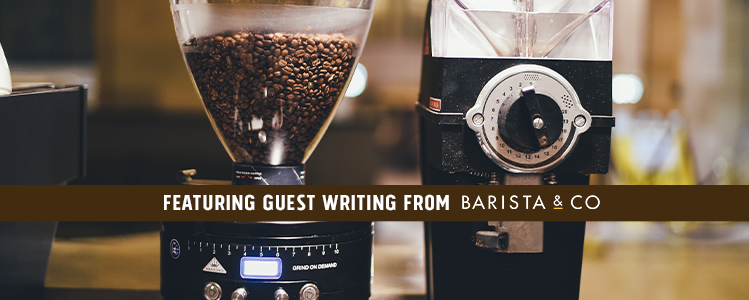It’s no secret that coffee tastes better when ground fresh. If you can grind your coffee beans just moments before brewing, you will get a far better flavour profile and intensity in your final cup of coffee.
This is the magic of a coffee grinder.
What is a Coffee Grinder?
A coffee grinder is fairly self-explanatory. It does exactly what you think it might; grind whole coffee beans into the most appropriate size for the desired brewing method.
Generally, coffee bean grinders work by generating friction between two abrasive surfaces or blades which have been calibrated to grind and pulverize the coffee beans to an exact size.
The way in which the coffee beans are ground, will make a difference to the overall flavour profile of the coffee at the end. Depending on the device used to grind them, varying chemical changes will take place within the bean, altering the taste.
Whole Bean vs. Ground Coffee
Whilst buying pre-ground packaged coffee can be convenient and cheaper, it will never compare to freshly ground whole bean coffee.
The second a coffee bean is ground, it’s volume of surface area exposed to the air is greatly increased. This means the degassing process begins, where the coffee releases carbon dioxide and starts to absorb oxygen instead. The absorption of oxygen makes coffee lose its flavour and it can begin to taste stale.
Whenever possible, it’s best to purchase high-grade specialty whole bean coffee from your local roasters or subscription service and invest in a coffee grinder that best suits you.
By buying whole bean coffee and grinding at home, means the exact amount of coffee can be ground on demand, leaving the rest of it whole bean, and preventing the oxidising process occurring before use. This keeps the coffee fresher for longer.
Standalone vs. Built-In Grinder
A question commonly asked when choosing the best coffee grinder is whether it’s worth investing in a standalone device or if the same results can be achieved using the integrated grinder built into the coffee machine.
Whilst a built-in grinder can offer convenience, ease and save money, it’s often true that it’s worth researching further into standalone grinders to achieve the best results.
Controlling Your Grind Size
Having the ability to accurately adjust your grind sizes can have an immense impact on the texture and flavour profile of a coffee. It is important to invest in a grinder that offers these intricate grind settings to achieve a high level of precision. It’s common for built-in grinders to have few settings and drastically leap from coarse to fine grind without sizes in between.
Grinder Repairs
Like with all technology and gadgets, it’s only a matter of time before something goes wrong. Annoying as it is, it’s often inevitable and unpreventable.
The benefit of having a standalone grinder means even when it fails on you, you still have the ability to make coffee (with pre-ground coffee) with your separate coffee machine. A machine with a built-in grinder means you may be without the machine for a while as you’ll have to send the entirety of the item off for repairs.
Be honest with yourself. Are you really going to cope without coffee whilst you wait for your machine to be fixed?!
Portability
Possibly an obvious point, but built-in grinders are hardly portable – at least not easily. Trust me, I’ve seen my boss try and carry one on his own and it’s safe to say he resembled a sweaty tomato, in desperate need of a lie down by the end of it. Not a good look.
Having a standalone coffee grinder means you can bring your fresh coffee with you; whether it’s in the middle of a field or in a hotel room in France.
Upgrading Opportunities
Everyone knows once you go down the route of specialty coffee, there is no going back - you’ll never again look twice at a coffee pod or at that jar of instant at the back of your kitchen cupboard. After all, you’ve levelled up.
And as with any obsession or passion, there is a constant curiosity to research more and keep up with the latest trends. This is the same in the coffee world, if not heightened.
With a tireless churn of new products and methods being created, it’ll be only a matter of time until you’re wanting to upgrade your coffee grinder. For those who use a coffee maker with a built-in grinder, this means upgrading everything.
A new coffee machine AND grinder, it may be a case of maxing out that new credit card of yours which is a hard pill to swallow.
With a standalone grinder, you’re at least able to upgrade one piece of equipment at a time. And trust me, your bank will appreciate this option a whole lot more.
Types of Coffee Grinders
Blade Grinders
Blade grinders, often the most inexpensive option available, work by using a blade to grind the coffee beans. Like a propeller, the blade spins quickly and slices the beans into smaller particles.
The size of the grind is determined by the length of time the beans are ground for in a blade grinder, making them slightly less precise than burr grinders.
Overall, blade grinders are great if you’re looking for a straightforward, slimline and low-cost device to deliver you super fresh ground coffee.
Burr Grinders
A burr grinder works by crushing the coffee beans against a static surface using a serrated grinder wheel mechanism. The size of the grind is determined by the position of the burr.
Burr grinders generally have more grind settings and with the ability to dictate the exact size, they allow for more precision than blade grinders.
There are two main types of burr grinders; conical and flat. They very in terms of cost, performance, and noise.
Manual Grinders
As the name suggests, manual grinders are the non-electric alternative in the world of grinders. These types of grinders often work by the turning of a crank, with the size of the grounds determined by how long the operator grinds for.
Due to the minimal technology required to manufacture manual grinders, these make for a great option if on a budget, prefer little noise or require a portable device that doesn’t require a power source.
When choosing the right grinder for you, it’s crucial to shop around and do as much research into all options as possible. The volume of grinder variants on the market these days can be overwhelming so it’s important to decide based on your coffee preferences and needs.
Once you find the grinder for you, you’ll never go back to pre-ground coffee again. And that’s a fact.


